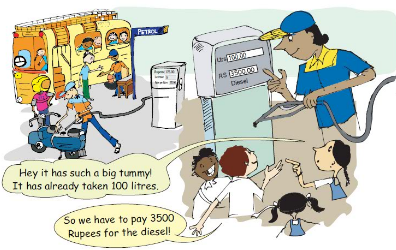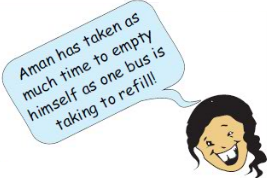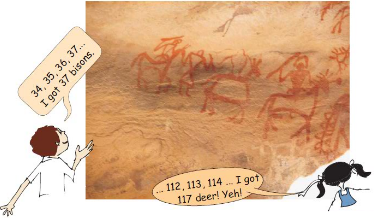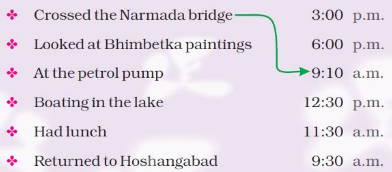GetStudySolution
Getstudysolution is an online educational platform that allows students to access quality educational services and study materials at no cost.
NCERT Solutions for class 4 Maths chapter 3 – A Trip To Bhopal
Back Exercise
Page No 23:
Question 1:
Today Sugandha is very excited. All the children of her school are going on a trip to Bhopal with their teachers. Ms. Meenakshi and Mr. Rakesh are talking about the number of buses needed. Ms. Meenakshi — We will need 4 buses. Mr. Rakesh — I think we need at least 5. Ms. Meenakshi — Each bus has 50 seats. Mr. Rakesh — Let us see how many children are going.
| Class | Number of children |
| IIIIIIIVV | 3332425053Total |
• So there are a total of __________ children going. • If they get 4 buses, how many children will get seats? _________ • Will there be any children left without seats?
Answer:
- 33 + 32 + 42 + 50 + 53 = 210
So there are a total of 210 children going.
- Number of students that 1 bus can take = 50
Number of students that 4 buses can take = 4
×50 = 200 Thus, 200 children will get seats in 4 buses.
- Number of students going to the trip = 210
Number of students who get seats = 200 Number of students without seats = 210 − 200 = 10 Therefore, 10 students will be left without seats.
Page No 24:
Question 1:
Each mini bus can take 35 students. How many mini buses are needed? ________________
Answer:
Total number of students going to the trip = 210 Number of students that one mini bus can take = 35 Number of mini buses required to take 210 students = 210
÷35 = 6 So, 6 mini buses are needed.
Page No 25:
Question 1:
• If they go to Bhimbetka, they will reach there
Answer:
If they go to Bhimbetka, they will reach there between 10 o’clock and 11 o’clock.
Page No 26:
Question 1:
• Was Victoria right?
Answer:
1 km = 1000 m 0.5 km = 500 m The bridge is 756.82 metres long. 756.82 metres is more than half a kilometre. So, Victoria was right.
Question 2:
• Have you ever crossed a long bridge? About how many metres long was it? ________
Answer:
The bridge was about 756.82 metres long.
Disclaimer: The answer may vary from student to student, based on his/her experience. The answer provided here is for reference only.
Question 3:
What is the difference between the water level of the Narmada in the rainy season and now? ___________ metres.
Answer:
At present, the water level is 40 metres below the bridge. In the rainy season, it is just 15 metres below the bridge. So, the difference between the water level of the Narmada in the rainy season and that at present is 40 m − 15 m = 25 m
Page No 27:
Question 1:
Each bus takes about 15 minutes to refill and there are two buses to be refilled. So they stop there for about __________ minutes, which means they are late by about _________ minutes.
Answer:
Time taken by 1 bus to refill = 15 minutes Time taken by 2 buses to refill = 2
×15 = 30 minutes So, the two buses take 30 minutes to refill. They are late by about 30 minutes. Each bus takes about 15 minutes to refill and there are two buses to be refilled. So, they stop there for about 30 minutes, which means they are late by about 30 minutes.
Question 2:

• Look in the picture and find the price of 1 litre of diesel. __________
Answer:
Quantity of diesel filled = 100 litres Total cost of 100 litres of diesel = Rs 3500 Cost of 1 litre of diesel = 3500
÷100 = 35 So, 1 litre of diesel costs Rs 35.
Question 3:
How much time did Aman take to come out of the toilet? ____________

Answer:
Aman took as much time as the bus took to refill, so he took 15 minutes to come out of the toilet.
Page No 29:
Question 1:

• How many more deer are there than bisons? ___________
Answer:
Number of deer = 117 Number of bison = 37 Number of deer more than bison = Number of deer − Number of bison = 117 − 37 = 80 There are 80 more deer than bison.
Question 2:
But Bonomala is the happiest because the number of people is even more than the number of deer and bisons together. Her count is less than 200. • How many people must Bonomala have counted? 214 / 154 / 134 / 177
Answer:
Let us calculate the number of bison and deer together = 117 + 37 = 154 We know that the number of people is greater than the number of deer and bison together. Also, we are given that the number of people is less than 200. It means that the number of people must be greater than 154 but less than 200. So, Bonomala must have counted 177 people.
Question 3:
• They have spent 1 hour there. What time is it? _________ They are now moving towards Bhopal. They should reach there in less than 1 hour, at about _________ o’ clock.
Answer:
They leave from Bhimbetka at 12:00. They are now moving towards Bhopal. They should reach there in less than 1 hour, at about 1 o’clock.
Page No 30:
Question 1:
Each child is to be given 1 orange, 1 banana and 5 biscuits. .png)
.png) All the children take oranges and biscuits but 38 children do not take bananas.
All the children take oranges and biscuits but 38 children do not take bananas. .png) • How many oranges, biscuits and bananas are distributed?
• How many oranges, biscuits and bananas are distributed?
Answer:
Total number of students going to the trip = 210 Each student was given 1 orange, 1 banana and 5 biscuits. So, Total number of oranges distributed to 210 students = 1
×= 210 = 210 We know that 38 students refused to take bananas. So, Total number of students who took bananas = 210 − 38 = 172 Total number of bananas distributed to 172 students = 1
×172 = 172 Also, Number of biscuits given to each student = 5 So, Total number of biscuits distributed to 210 students = 210
×5 = 1050 So, 210 oranges, 172 bananas and 1050 biscuits were distributed among all the students going to the trip.
Question 2:
I gave four toffees each to four of my friends and three toffees are left with me. How many toffees did I have?
Answer:
Number of toffees I gave to my friends = 4 × 4 =16
After giving the toffees,
Number of toffees left with me = 3
Total number of toffees with me = Number of toffees given to friends + Number of toffees left with me = 16 + 3 = 19 So,
Total number of toffees I had = 19
Question 3:
What numbers can you make using 3, 5 and 7? You can make 357 and 537. What others?
Answer:
The other numbers that you can make using 3, 5 and 7 by keeping one of the numbers fixed at the beginning are 375, 573, 735 and 753.
Question 4:
A number becomes double if it is increased by 8. What is the number?
Answer:
We will use the hit and trial method to solve this question. Let the number be x. Now, if the number is increased by 8, it becomes double. So, we have x + 8 = 2x Put x = 5. 5 + 8 ≠ 2 × 5 Put x = 6. 6 + 8 ≠ 2 × 6 Put x = 7. 7 + 8 ≠ 2 × 7 Put x = 8. 8 + 8 = 2 × 8 Therefore, the number is 8.
Page No 31:
Question 1:
Think of a number which can be divided by 2, 3 and 5 and comes between 25 and 50.
Answer:
Numbers between 25 and 50 that are divisible by 2: 26, 28, 30, 32, 34, 36, 38, 40, 42, 46, 48 Numbers between 25 and 50 that are divisible by 3: 27, 30, 33, 36, 39, 42, 45, 48 Numbers between 25 and 50 that are divisible by 5: 30, 35, 40, 45 So, the smallest number between 25 and 50 that can be divided by 2, 3 and 5 is 30.
Question 2:
A small ant climbs 3 cm in 1 minute but slips down 2 cm. How much time will it take to climb to 2 cm?
Answer:
The small ant climbs 3 cm in 1 minute and slips down 2 cm. So, Distance covered by the ant in 1 minute = 3 − 2 = 1 cm Thus, the ant will take 2 minutes to cover a distance of 2 cm.
Page No 33:
Question 1:
There are different kinds of boats. Each has a different ticket price, and also different trip times.
| Name of the Boat | Ticket-price | Trip-time |
| 1. Double-decker | Rs 30 | 45 minutes |
| 2. Paddle-boat | Rs 15 | 30 minutes |
| 3. Motor-boat | Rs 25 | 20 minutes |
| 4. Boat with oars | Rs 15 | 45 minutes |
• Indra and Bhanu first went in the motor-boat, and then took the oar-boat. How much did they pay for both the boats? Rs _____________ How much time did they get for both rides? ______________
• One group of children went for the double-decker trip. They paid Rs 450 in total. How many children went for the double-decker trip? ____________
• Which boat makes two trips in 1 hour?
• Which boat takes less than half an hour to complete a trip?
• Which boat gives them the most time taking the least money?
• Javed went twice for boating. He paid a total of Rs 40. and boated for 50 minutes. Which two boats did he take? _____________
Answer:
• Money Indra and Bhanu paid for the motorboat = Rs 25 + Rs 25 = Rs 50 Money paid by them for the oar boat = Rs 15 + Rs 15 = Rs 30 Total money Indra and Bhanu paid for the motorboat and the oar boat = Rs 50 + Rs 30 = Rs 80 Time for the motorboat ride = 20 minutes Time for the oar boat ride = 45 minutes Total time for both the rides = 20 + 45 = 65 minutes
• Money spent by the group of children for the double-decker trip = Rs 450 Price of the double-decker trip per child = Rs 30
Number of children =
Total money spent for the double-decker tripPrice of the double-decker trip for one child =
45030 = 15 Now, Number of children who went for the double-decker trip = 15
• We know 1 hour = 60 minutes We can see from the table that the paddle boat takes 30 minutes to complete a trip. So, the paddle boat will take 2 trips in 60 minutes.
• We know Half an hour = 30 minutes From the table, we can see that the motorboat takes 20 minutes to complete a trip. So, the motor boat takes less than 30 minutes to complete a trip.
• From the table, we can see that the least money, that is, Rs 15, is charged by the paddle boat and the oar boat. Also, the oar boat trip gives more time compared to that given by the paddle boat for the same money.
• Javed went twice for boating. Money paid by him is Rs 40 and the total time spent by him is 50 minutes. From the table, we can see that Javed took the paddle boat and motorboat trips, which together cost him Rs 40. Also, the total time spent on both the boats is 50 minutes.
Question 2:
Children enjoy different boat rides till 4 o’clock. It is time to return. Now they will not stop anywhere and reach back in two hours. So, they should reach Hoshangabad by ___________ o’clock.
Answer:
They should reach Hoshangabad by 6 o’clock.
Page No 34:
Question 1:
Practice Time 1. There are four very old cave-paintings. Mark the oldest. (a) 4200 years old (b) 1000 years old (c) 8500 years old (d) 1300 years old
2. One bus can carry 48 children. How many children can three buses carry? About — (a) 100 (b) 200 (c) 150
3. Which pair of numbers add to make more than 500? (a) 152 and 241 (b) 321 and 192 (c) 99 and 299 (d) 401 and 91
4. What happened at what time? Draw lines to match. 
Answer:
1) There are four very old cave paintings. The oldest painting is 8500 years old.
Hence, the correct option is (c).
2) Number of children in 1 bus = 48 Number of children in 3 buses = 48
×3 = 144 There are about 150 children.
Hence, the correct option is (c).
3) We will add the pairs to check the pair that has the sum greater than 500.
152+241393 1321+192513 1199+291390 401+91492We can see that 321 and 192 together make more than 500.
Hence, the correct option is (b).
4)
.png)